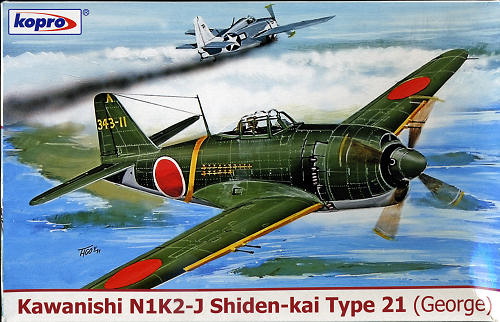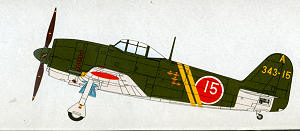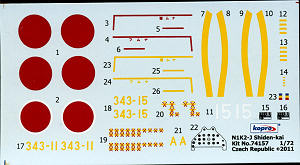
Kopro 1/72 N1K2-Ja Shiden-Kai
| KIT #: | 74157 |
| PRICE: | 260 Koruna (about $13 USD) from www.hobbyshop.cz |
| DECALS: | Two options |
| REVIEWER: | Scott Van Aken |
| NOTES: |

| HISTORY |
The Kawanishi N1K Kyōfū (強風 "strong wind", Allied reporting name "Rex") was an Imperial Japanese Navy floatplane fighter. The Kawanishi N1K-J Shiden (紫電 "Violet Lightning") was an Imperial Japanese Navy Air Service land-based version of the N1K. Assigned the Allied codename "George", the N1K-J was considered by both its pilots and opponents to be one of the finest land-based fighters flown by the Japanese during World War II.
The N1K possessed a heavy armament and, unusual for a Japanese fighter, could absorb considerable battle damage. The N1K-J evenly matched the F6F Hellcat and was a better match than the A6M Zero for such aircraft as the F4U Corsair and P-51 Mustang. Despite such capability, it was produced too late and in insufficient numbers to affect the outcome of the war.
The N1K1 entered service in early 1944 and proved highly effective against American fighters. The Kawanishi was among the few Japanese fighters that could stand up to the best enemy types, including Hellcats and Corsairs. In the hands of aces, the Shiden could even outfly its American opponents. In February 1945, Lieutenant Kaneyoshi Muto, flying a N1K2-J as part of a group of at least ten expert Japanese fighters, faced seven U.S. Navy Hellcats of VF-82 in the sky over Japan. His group shot down four Hellcats with no loss to themselves. After the action, reporters fabricated a story in which Muto was the sole airman facing 12 enemy aircraft.
They were, however, mechanically unreliable. The engine was difficult to maintain and, like the complicated undercarriage, plagued by frequent failures. N1K1-J aircraft were used very effectively over Formosa, the Philippines and later, Okinawa. Before production was switched to the improved N1K2-J, 1,007 aircraft were produced, including prototypes.
Problems resulted in very few N1K2-J aircraft being produced, but the Shiden-Kai proved to be one of the best "dogfighters" fielded by either side. Along with high speed, the fighters were very agile with a roll rate of 82°/sec at 386 km/h (240 mph). Their weaponry comprising four 20 mm cannons in the wings was highly effective. As a bomber interceptor, the N1K2-J was less successful, hampered by a poor rate of climb and reduced engine performance at high altitude.
Surprisingly, four aircraft are still extant. Three in the US and one, pulled from the waters of the Bungo Straight and not restored, is in Japan. This latter airframe was one used by the 343 Kokutai, the elite unit of aces.
| THE KIT |
 This
is the first new release kit I have seen from Kopro in many, many years and I have
to say that I am quite impressed. The kit has the level of detailing you would
expect from Revell or Hasegawa with crisply molded lines and alignment pins that
actually mate up the surfaces correctly. I test fit the fuselage and wing pieces
and was delighted with the way they went together. The detailing in the cockpit
is first rate with the rudder pedals molded to a detailed floor to which you add
the seat and rear bulkhead. the instrument panel has a decal sheet that fits
over it, and while I am not sure it should be white, it will look the part.
This
is the first new release kit I have seen from Kopro in many, many years and I have
to say that I am quite impressed. The kit has the level of detailing you would
expect from Revell or Hasegawa with crisply molded lines and alignment pins that
actually mate up the surfaces correctly. I test fit the fuselage and wing pieces
and was delighted with the way they went together. The detailing in the cockpit
is first rate with the rudder pedals molded to a detailed floor to which you add
the seat and rear bulkhead. the instrument panel has a decal sheet that fits
over it, and while I am not sure it should be white, it will look the part.
The Shiden-kai did not have a lot of bits you can stick under it and this is basically left down to a drop tank. The holes for the tank mount are already formed so if you wish to skip the tank you will need to fill the holes. Interestingly, these mounting holes do not go all the way through the lower wing, but are backed by little 'cups'. Not something I have seen very often. The engine face is well detailed and I like that the prop is a single piece. The only possible pesky ejector pin marks are on the inside of the main gear doors. However, these may well be covered by the landing gear struts once the kit is built. Another nice option is providing both a one-piece and multi-piece canopy. I am not sure if the canopy itself will be thin enough to slide over the rear section if you wish to display it open as the plastic is a bit thick, but one will see.

 Instructions
are well drawn with eleven construction steps. Paint information is via Humbrol,
Agama and FS 595 references. The decal sheet is superb and provides markings for
two aircraft from the 343 Hikoki. IOne is the box art plane with an impressive
victory tally while the other has the number 15 painted or chalked in to the
fuselage Hinomaru. For those who may want different markings, Kopro and others
make alternate decals. The kit sheet includes a full set of stencil decals and
insignia for one aircraft.
Instructions
are well drawn with eleven construction steps. Paint information is via Humbrol,
Agama and FS 595 references. The decal sheet is superb and provides markings for
two aircraft from the 343 Hikoki. IOne is the box art plane with an impressive
victory tally while the other has the number 15 painted or chalked in to the
fuselage Hinomaru. For those who may want different markings, Kopro and others
make alternate decals. The kit sheet includes a full set of stencil decals and
insignia for one aircraft.
| CONCLUSIONS |
I have to say that I am very impressed with this one and I see that it has been done in a few other boxings. I very much look forward to seeing other kits like this from Kopro and perhaps these will be the folks that produce a new tool Kate. This one is already on the bench so stay tuned for a full build review. As a final note, I have been told that this may well be a reboxing of the Aoshima kit. If so, it is still very nice and comes with what is probably a much better decal sheet.
| REFERENCES |
http://en.wikipedia.org/wiki/Kawanishi_N1K2-J
July 2012
Thanks to www.hobbyshop.cz for the preview kit. You can buy yours from the link.
If you would like your product reviewed fairly and fairly quickly, please contact the editor or see other details in the Note to Contributors.